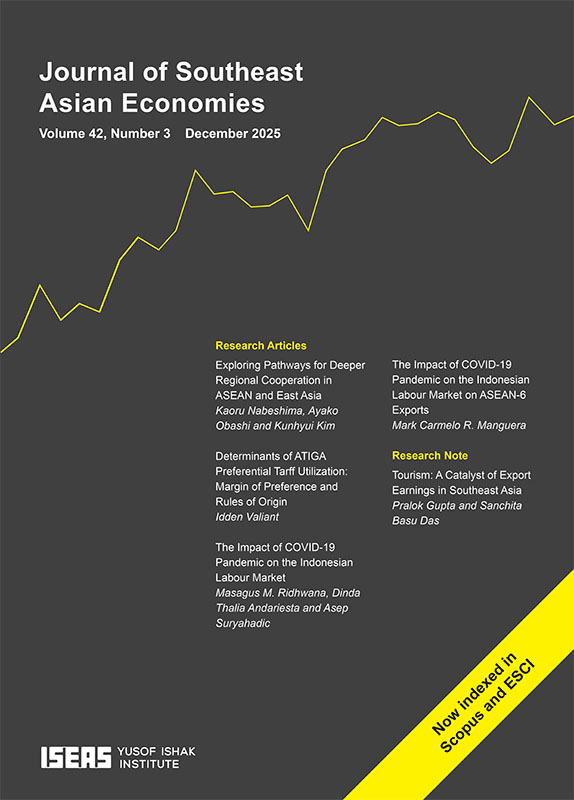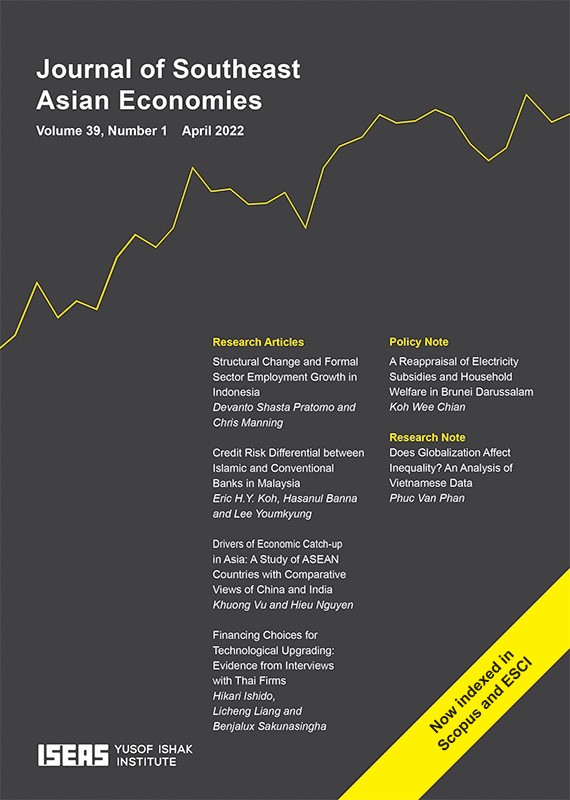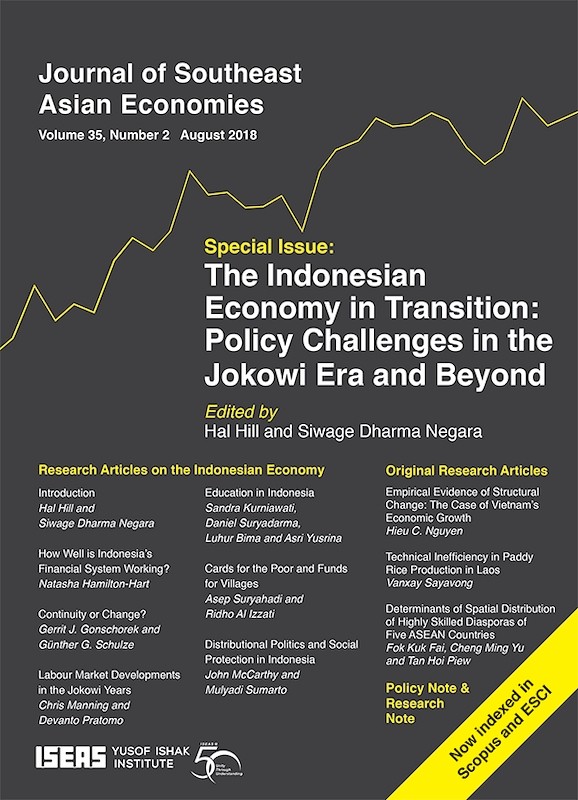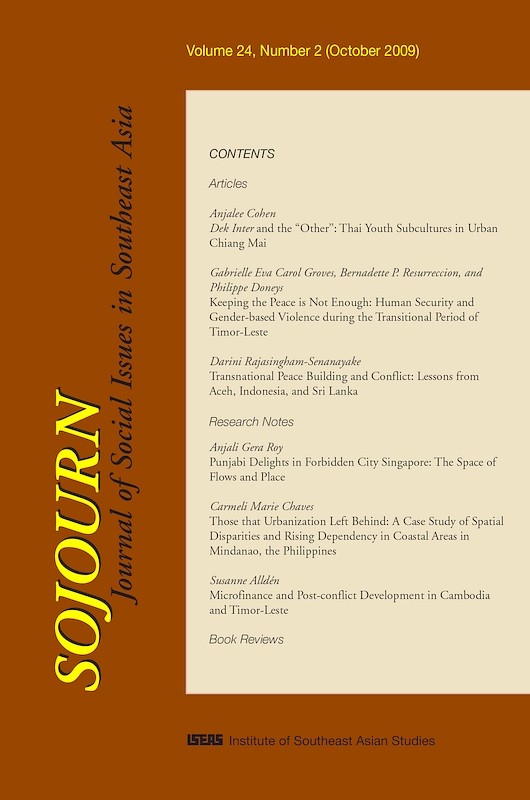Journal of Southeast Asian Economies Vol. 40/2 (August 2023)
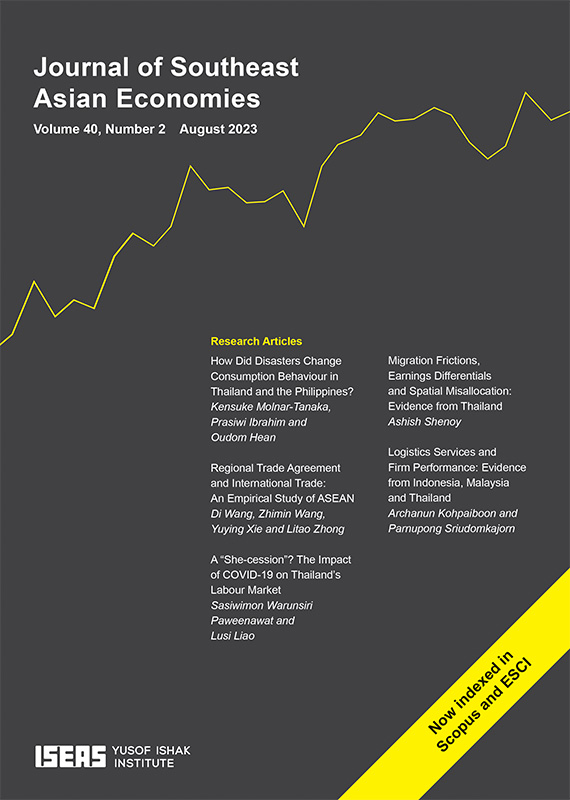
Date of publication:
August 2023
Publisher:
ISEAS – Yusof Ishak Institute
Number of pages:
124
Code:
AE40/2
Soft Cover
ISSN: 23395095
Contents
-
Journal of Southeast Asian Economies Vol. 40/2 (August 2023)
[Whole Publication, ISSN: 23395206] -
Preliminary pages
- RESEARCH ARTICLES
-
1. How Did Disasters Change Consumption Behaviour in Thailand and the Philippines?, by Kensuke Molnar-Tanaka, Prasiwi Ibrahim, Oudom Hean, authors see abstractThis study examines the effects of disasters on consumption in Thailand and the Philippines, using three major natural hazards for each country, including the 2004 tsunami, the 2011 and 2016–17 floods in Thailand, and typhoons Bopha, Haiyan and Meranti in the Philippines. To examine the effects of a disaster on total consumption, this study uses an interrupted time-series analysis. A decline in consumption is observed after a disaster in Thailand, stemming from a reduction in expenditure of the services sector including recreation, restaurants, and hotels, though the decline is partially offset by increased spending on non-durable goods. For the Philippines, declines in overall consumer spending are observed in response to these disasters with no specific sectoral responses in the sample. When a disaster hits, reactions from governments are crucial to providing immediate help to victims, which could have an impact on consumption and overall economic activity. These reactions take the form of emergency relief and assistance including compensation schemes, as well as helping with reconstruction. However, developing longer-term disaster mitigation and resilience policies is also crucial to prevent or prepare for future disasters.
-
2. Regional Trade Agreement and International Trade: An Empirical Study of ASEAN, by Di Wang, Zhimin Wang, Yuying Xie, Litao Zhong, authors see abstractThis paper analyses the actual impact of import tariffs and of ASEAN membership on trade flows of ASEAN member countries and non-member countries. The Poisson Pseudo-Maximum Likelihood (PPML) econometric model is used to obtain consistent estimates in the presence of heteroscedasticity. Three groups of fixed effect variables are used to address concerns related to omitted control variables. The findings show that, while low import tariffs promote imports of the member countries, they also boost exports from the member countries. More interestingly, the effect spills over to the non-member major trade partners even though the impact is more prominent for member countries, which can be attributed to ASEAN’s recent efficiency improvements. This study also sheds light on the prospect of the Regional Comprehensive Economic Partnership (RCEP) on account of the overlap between RCEP and ASEAN.
-
3. A “She-cession”? The Impact of COVID-19 on Thailand’s Labour Market, by Sasiwimon Warunsiri Paweenawat, Lusi Liao, authors see abstractThis paper studies the impact of COVID-19 on different demographic groups in the Thai labour market using the Labour Force Surveys conducted in 2018 and 2019. We construct a new set of COVID-19 impact indicators capturing both the degree of risk in industries and the degree of occupational flexibility in the Thai context. The results show that the effect of COVID-19 is highly divergent across demographic groups, which may further worsen the pre-existing inequality in the Thai labour market, given the composition of industrial sectors and occupations. The results also indicate that education attainments and income levels play a significant role in protecting individuals, suggesting the key contribution of human capital. In addition, marriage affects men and women workers differently during the crisis, with married women appearing to suffer more. Finally, this study highlights the need for targeted government support to vulnerable groups, including workers with low education, informal sector workers, private employees, older women and the young, who are more likely to be affected by COVID-19.
-
4. Migration Frictions, Earnings Differentials and Spatial Misallocation: Evidence from Thailand, by Ashish Shenoy, author see abstractThis paper quantifies the disutility of labour migration, characterize the migration contribution to labour supply elasticity, and estimate the effect of migration frictions on spatial earnings differentials and labour misallocation in Thailand. The study structurally estimates a spatial equilibrium model using commodity prices as instruments for local earnings to overcome endogeneity and selection, and to identify the net present value returns to potential migration. The findings show that migration contributes 9.5 percentage points to labour supply elasticity at the extensive margin, which is 25–50 per cent as large as existing intensive-margin estimates among non-movers. The disutility from migration is 1.0–1.2 times annual earnings; alleviating this friction would induce a quarter of the population to relocate and lower spatial earnings variation by 20 per cent. However, gains would be realized primarily in non-wage utility with a modest 3 per cent increase in national product, suggesting migration frictions play a limited role relative to preference heterogeneity in productive misallocation.
-
5. Logistics Services and Firm Performance: Evidence from Indonesia, Malaysia and Thailand, by Archanun Kohpaiboon, Parnupong Sriudomkajorn, authors see abstractThis paper examines whether logistics upgrading activities undertaken by firms can compensate for the poor quality of logistics infrastructure at the national level. To do so, the study makes use of the World Bank’s Enterprises Surveys (ESs) of Indonesia, Malaysia and Thailand for the 2015–16 period. This is the first study to analyse the logistics upgrading efforts of firms across multiple Southeast Asian countries. The key finding is that, while Indonesia lags behind the other two ASEAN members in terms of physical infrastructure investment, cumbersome regulatory procedures are the common challenge in all three countries. The inter-country, firm-level cross-sectional econometric analysis suggests that there is ample room for firms to improve their logistics capabilities to mitigate related bottlenecks at the national level. Moreover, certain forms of subsidies or tax incentives might be needed to offset the additional costs incurred by the firms.

